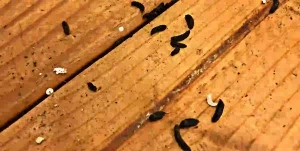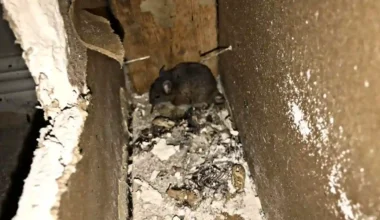Mice are known for their unsanitary habits of leaving behind droppings and urine wherever they roam. Also, the droppings can be a clear indication of their presence and can pose a significant health risk to anyone present in the vicinity. Thus, you want to clean mice droppings in attic as soon as possible.
How to clean mice droppings in attic

Before cleaning the droppings, you want to eliminate the mice from the attic. Simply cleaning the attic will not prevent them from returning to leave more droppings, potentially contaminating previously disinfected areas. Here is a guide to help you safely clean mice droppings in attic:
1. Remove the droppings and urine
Instead of using a vacuum or broom, it is recommended to manually pick up the droppings and nesting materials. This helps to prevent the spread of dust and waste.
When cleaning the attic, wear rubber gloves and kit up with your PPE (personal protective equipment) to protect yourself. A mask should also be worn to avoid inhaling dust and potential pathogens.
Disinfect the droppings by spraying them with a solution of bleach and water (1 part bleach to 10 parts water) and allowing the solution to sit for 5 minutes. Vinegar is not an effective alternative.
If using a store-bought disinfectant, follow the instructions on the label. Use disposable rags or paper towels to pick up the droppings and place them in a sealed trash bag for disposal.
2. Dispose of any dead mouse safely
While still wearing the protective gear to clean mice droppings in attic, carefully remove and dispose of dead mice.
Spray another round of disinfectant in its surrounding area and let it soak for about 5 minutes.
Wipe the area with a rag or paper towel. Extract the dead rodent along with the nesting materials and put them inside a plastic bag. Seal the bag tightly before throwing it in a sealed garbage can.
3. Look for any exposed insulation
Insulation is one of the reasons why rodents choose to build their nests in attics. Although the insulation material may not be a food source for the mice, they still chew on it to keep their teeth trimmed.
During the cleaning process, inspect any exposed insulation for urine and droppings. If present, handle the contaminated material carefully and place it in plastic bags for disposal.
If the insulation is damaged, it will need to be replaced with new material.
4. Get rid of all contaminated materials
Attics often serve as additional storage space in homes, but the clutter in these areas can attract mice and other rodents to build their nests. So, after you clean mice droppings in attic, you want to decontaminate any affected materials.
To decontaminate your clothing, Stuffed Animals, and Bedding, wash them in a washing machine with laundry detergent and allow them to dry in the sun for several hours.
For your contaminated carpets and upholstered furniture, use a commercial-grade steam cleaner and disinfectant to eliminate bacteria and other contaminants.
If you have non-washable items, take advantage of the ultraviolet rays from the sun to inactivate hantaviruses. Just leave the items in the sun for several hours. After drying them, wipe them with a cloth dampened with disinfectant.
5. Disinfect your attic
Mop and wipe down the attic with a disinfectant. Ensure that the entire area is thoroughly cleaned to remove any odor from the rodent urine and poop.
Upon completion, remove the rubber gloves and wash your hands with soap and warm water. For added protection, you can also use an alcohol-based hand sanitizer.
Is it normal to have mouse poop in attic?
It’s not normal to find mice poop in your attic — in fact, it suggests an infestation. And that infestation could be severe, depending on the quantity of mouse poop around.
Your attic is a popular location for mice to reside due to the insulation. Unfortunately, mice presence in any part of a home, including the attic, poses a significant health risk, as their droppings can contaminate food and water supplies if they are exposed, according to the FDA.
What do mice droppings look like?
Mice droppings usually measure around ¼ inch in length. To determine their freshness, observe the color. Fresh mice droppings will appear darker and have a shinier texture, whereas older droppings will seem dry and chalky. Rat excrements have a similar shape but are bigger, with a length between ½ to ¾ inches and blunt ends.
Older droppings will appear lighter and drier, indicating that the mice have not been active in the attic for a while.
Despite their small size, mice are capable of producing a significant amount of droppings, around 50 to 75 per day.
In addition to seeing the rodents themselves, their droppings can provide valuable information on the specific species present in your home. This information can assist exterminators in determining the most effective control methods to clean mice droppings in attic.
The droppings also give insights into the level of rodent activity and the potential size of the infestation. The presence of more droppings in areas frequently visited by the rodents, such as their nest, indicates a larger infestation. The color of the droppings can also provide information on the recent activity of the mice.
Diseases Transmitted by Rodent Droppings
Even after the removal of mice, their droppings and urine can still contaminate food and water sources, creating an unsanitary environment that can pose a threat to your family’s health. Here are some of the diseases caused by contamination from mouse droppings:
1. Hantavirus Pulmonary Syndrome (HPS)
HPS is a viral disease that is transmitted through direct contact with rodent waste or the inhaling of contaminated dust. Early symptoms include muscle aches, fever, fatigue, nausea, diarrhea, abdominal pain, and dizziness.
2. Leptospirosis
This bacterial disease can be contracted through ingestion of food or water contaminated with urine or droppings from infected rodents or through contact with contaminated water or soil. Symptoms include fever, chills, muscle aches, vomiting, rash, red eyes, and jaundice.
3. Salmonellosis
This bacterial illness is contracted through the consumption of food or water contaminated with rodent feces. Symptoms include diarrhea, stomach cramps, and fever.
How long do mouse droppings remain infectious?
The virus in mouse droppings can maintain remain infectious for 2 to 3 days when kept at room temperature. Sunlight exposure can reduce the duration of viability while freezing temperatures can prolong the virus’s infectiousness.
What disinfectant kills mouse droppings?
To disinfect areas contaminated with rodent droppings, urine, or organic debris, prepare a solution by mixing 1.5 cups of bleach with a gallon of water.
Conclusion – clean mice droppings in attic
Mice droppings in the attic must be cleaned up for a healthier and safer home. By following the steps above, you can safely and successfully get rid of mice droppings in your attic, lower the risk of disease, and stop more mice from coming in.
Ultimately, get to the bottom of this problem by blocking off entry spots, setting traps, and maybe even hiring a professional pest control service to make sure the problem is solved for good.






